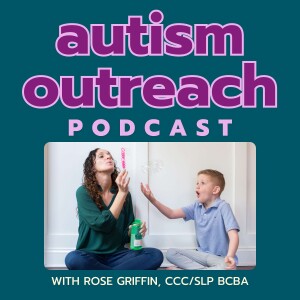
Autism Outreach - Easy Strategies For Parents and Professionals
Kids & Family:Parenting

#029: Play-Based Therapy - A Conversation with Emily Cohen
 2021-07-13
2021-07-13
Download
Right click and do "save link as"
Play-Based Speech Therapy can open the door to so much interaction. My guest, Emily Cohen, talks about using Play-Based Therapy with her clients and all of the benefits it can provide. Emily Cohen works with families with children as young as 15 months old, coaching the parents. We talk about all the elements of play, interaction, and language and I share some pretty cute anecdotes from my therapy experiences with play.
Engagement is such a huge part, and the more they are engaged the more meaningful their learning will be. Imitation and nonverbal imitation can be the start of engaging in play. Emily shares the idea of a mirror “game”, sitting in front of a mirror practicing making large body movements, and even using hand over hand when needed.
Patience, flexibility, and following the child’s lead is key when creating an engaging play space for therapy. Kids may not always use or interpret toys or activities in the way we expect things which can make for even more enriching experiences.
Stay away from toys that have batteries. When we are interacting with a child and a toy that has all the bells and whistles, moving and making noise, the toy ends up doing the work. Go back to basics and allow the student to use the toy as a prop so that you can truly build new and meaningful interaction.
Interaction comes before language, so there are so many opportunities for skills in play even nonverbally. As a speech therapist, Emily coaches parents on playing with their children and working with their kids to find these opportunities. Her advice for parents is to remind them that they are their child's best teacher, every time their child is watching them is an opportunity for learning.
What’s Inside:
Engagement is such a huge part, and the more they are engaged the more meaningful their learning will be. Imitation and nonverbal imitation can be the start of engaging in play. Emily shares the idea of a mirror “game”, sitting in front of a mirror practicing making large body movements, and even using hand over hand when needed.
Patience, flexibility, and following the child’s lead is key when creating an engaging play space for therapy. Kids may not always use or interpret toys or activities in the way we expect things which can make for even more enriching experiences.
Stay away from toys that have batteries. When we are interacting with a child and a toy that has all the bells and whistles, moving and making noise, the toy ends up doing the work. Go back to basics and allow the student to use the toy as a prop so that you can truly build new and meaningful interaction.
Interaction comes before language, so there are so many opportunities for skills in play even nonverbally. As a speech therapist, Emily coaches parents on playing with their children and working with their kids to find these opportunities. Her advice for parents is to remind them that they are their child's best teacher, every time their child is watching them is an opportunity for learning.
What’s Inside:
- Play-Based Speech Therapy
- Following the child’s lead
- Open-Ended Toys
- Facilitating social, play, and language interaction
- Interaction before language
More Episodes
#188: Parent Training with Dr. Janie Funk
 2024-08-06
2024-08-06
 2024-08-06
2024-08-06
#185: Replay: The Power of Joint Attention
 2024-07-16
2024-07-16
 2024-07-16
2024-07-16
#183: My First Year With AAC
 2024-07-02
2024-07-02
 2024-07-02
2024-07-02
012345678910111213141516171819
Create your
podcast in
minutes
- Full-featured podcast site
- Unlimited storage and bandwidth
- Comprehensive podcast stats
- Distribute to Apple Podcasts, Spotify, and more
- Make money with your podcast
It is Free
- Privacy Policy
- Cookie Policy
- Terms of Use
- Consent Preferences
- Copyright © 2015-2024 Podbean.com




